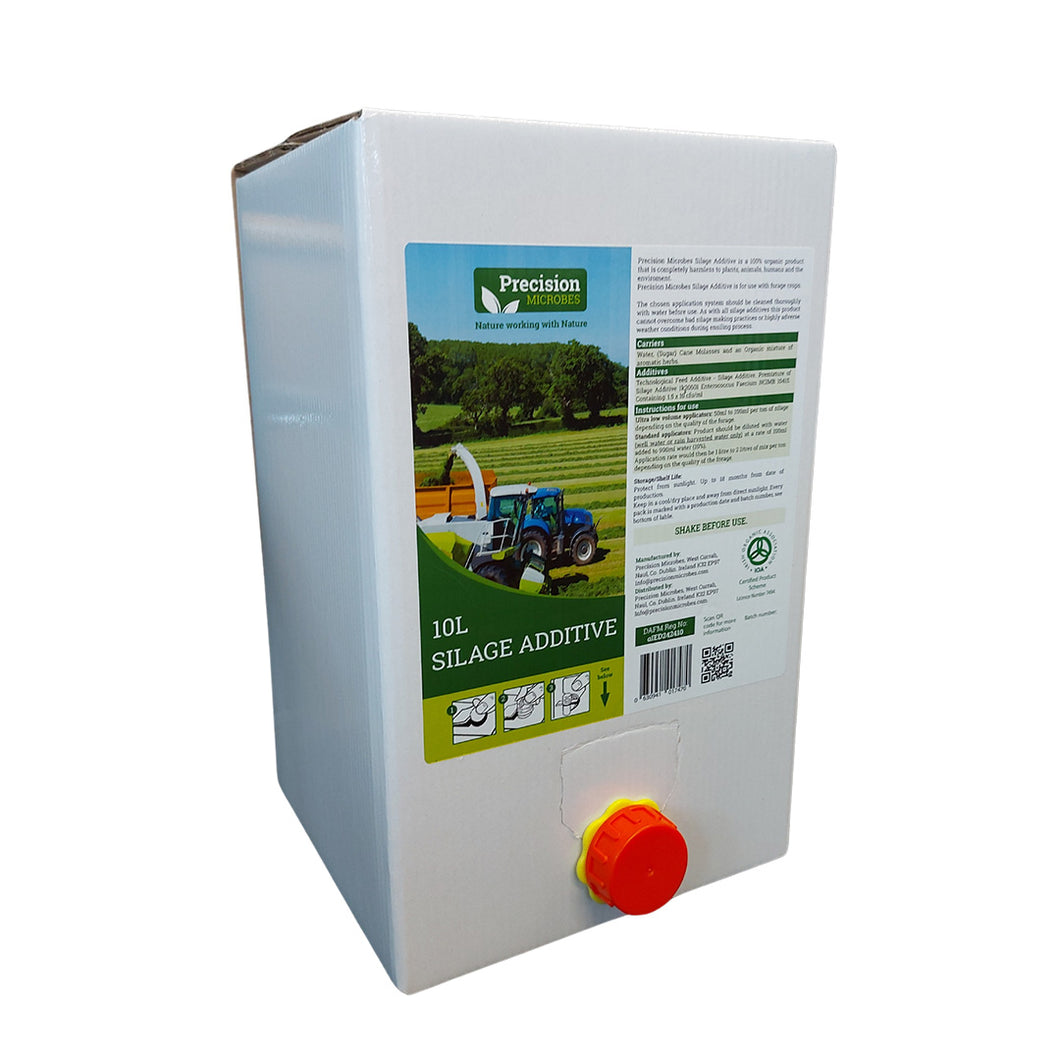
Precision Microbes Silage additive 10L
Regular price
€100.00
Sale
10L will treat 100 tonnes of silage.
Fuelling Fermentation In Modern Silage Making
With Precision Microbes
The ensiling of grass is the main method of forage conservation employed in Ireland. This involves a controlled microbial fermentation of your harvested crop. Preserving your silage is largely dependent on the actions of lactic acid forming bacteria in an anaerobic environment.
Precision Microbes silage additive is a ready-to-use means of delivering live homofermentative lactic acid forming bacterial species (LAB) into your silage clamp and bales.
Dose Rates
How Precision Microbes Works
Live Microbial Agents
The presence of live bacterial species at high concentrations means this ready-to-use product is effective immediately when applied and especially when harvested grass is introduced to a sealed anaerobic environment (i.e., when bales are wrapped or when clamps are sealed). At this concentration these microbes rapidly out-compete undesirable bacteria which are present in every clamp/bale.
Drive A Rapid Decline In pH
Homofermentative lactic acid forming bacteria utilise grass sugars to produce high concentrations of lactic acid, the crucial determinant of pH within every clamp/bale. Homofermentative lactic acid forming bacteria are more efficient at producing lactic acid from hexose sugars in your grass than their heterofermentative counterparts. In fact, they produce twice as much lactic acid from glucose and are 6 times more efficient at producing it from fructose (see attached)! This also protects your harvested crop from the actions of undesirable bacteria and yeasts, which tolerate high pH.
Nutrient Preservation
Undesirable bacteria which also grow in the anaerobic conditions produced in your clamp/bales can degrade the lactic acid required for optimal fermentation and break down the valuable protein needed for herd productivity when fed, especially when the drop in pH is slow. This in turn produces weak acids, poor fermentation quality, a reduced feed value, and an unstable, unpalatable (and potentially toxic) end product. Homofermentative lactic acid forming bacteria preserve a forage’s nutritional content, ensuring a high-quality feedstuff for livestock.
Voluntary Dry Matter Intakes
The intake of silages can be reduced when a slow and undesirable fermentation process has taken place. This is due to the presence of unpalatable end products such as weak acids from their fermentation of simple sugars (like acetic acid and butyric acid) and biogenic amines from the degradation of protein (like cadaverine, histamine, and putrescine). Crop fermentation driven by homofermentative microbes minimise the risk posed by this, and therefore it promotes intakes and reduces feed waste.
Animal Health Protection
The prevention of animal disease is of paramount importance for every herd. By promoting an efficient and efficacious lactic acid based fermentation process this homofermentative inoculant can minimise the presence of a host of pathogenic bacteria and yeasts which can severely impact your herd’s health. Considering silage is predominantly fed when adult animals are pregnant and in early lactation this is a major advantage. Precision Microbes is a biome-focused solutions company which has a vast array of experiences in enhancing on-farm microbiota for the benefit of the individual animal and the herd, and we see this silage inoculant as a part of that story.
Animal Health Protection
Considering grass silage will be the predominant component of the diet for many months it is unsurprising that there are performance benefits linked to an optimum fermentation process driven by homofermentative lactic acid forming bacteria. These include an increase in silage digestibility, milk yield, and liveweight gain.
Environmental Impact/Sustainability
Silages fermented by homofermentative lactic acid forming bacteria produce less carbon dioxide (CO2) and hydrogen (H2) than the unfavourable microbes – These are building blocks of methane (CH4). The rapid fermentation process promotes the utilisation and/or preservation of nutrients and therefore minimises effluent leaching of nutrients. Furthermore, the proportion of CH4 produced per kilogram of milk or beef is lower in healthy cattle consuming high levels of quality feed (i.e., a higher efficiency of utilisation).
